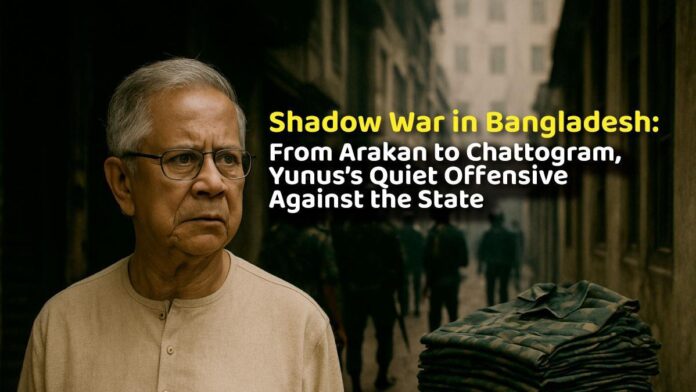When a nation begins to burn, the fire rarely starts in the open. It begins in whispers, in secret deals, in money wired without names, in uniforms stitched not for protection but for betrayal.
This is the reality unfolding in Bangladesh—a slow-burning, carefully crafted conflict orchestrated not from foreign borders, but from within. And at the center of this shadowy war stands Dr. Muhammad Yunus, no longer just a Nobel laureate, but a proxy commander of a veiled rebellion.
Uniforms of Insurrection
In the port city of Chattogram, authorities recently intercepted a chilling cargo—20,000 military-grade uniforms, tailored not for the national army, but for the separatist group KNF (Kuki-Chin National Front). These weren’t smuggled in from across the border. They were made right here, in plain sight, by tailors in downtown Chattogram, operating under the comfort of money—two crore taka in contracts—and even more dangerous, under political protection.
The trail led not to the hills, but to the drawing rooms of Dhaka’s elites, where shadows stretch long and loyalties grow thin.
The Invisible Battle Lines
According to intelligence sources, a silent power struggle is underway between Yunus’s informal circle and the standing defense leadership, including General Waker-uz-Zaman. While the police appeared hesitant—perhaps even intimidated—to expose the operation, military intelligence refused to stay silent. They understood: a uniform can be as deadly as a weapon. Especially when stitched for sedition.
This was not just a law enforcement failure. It was a test of the state’s sovereignty.
Behind the Curtain: A Soft Coup in Slow Motion
Yunus has become a symbol of contradiction—preaching peace in Geneva, while enabling rebellion in Bandarban. His global image as a microfinance messiah masks what many now fear is an insidious plan to destabilize Bangladesh from within.
Whispers among diplomats, anonymous security reports, and the silent movement of money and materials all point to a coordinated strategy: discredit the state, fracture its institutions, fuel unrest in the periphery, and call it a “democratic crisis” for global applause.
This isn’t speculation—it’s unfolding fact.
Who’s Really in Control?
The very idea that separatist groups could be armed, funded, and dressed under the nose of national agencies speaks volumes. The deeper fear is not about who stitched the uniforms, but about who ordered them—and more importantly, who protected them.
Media houses remained silent. Local police tried to suppress the story. But questions remain:
• Who made the call to keep it quiet?
• Who benefits from chaos in the hills?
• And why is the West so ready to echo Yunus’s cries of “crisis,” while ignoring the embers he lights?
The Real War is for Bangladesh’s Soul
What’s happening in Chattogram and the Chittagong Hill Tracts is not isolated. It is part of a broader project: to weaken Bangladesh’s internal cohesion, destabilize its military confidence, and paint the country as a failed state in need of international “intervention.”
Yunus’s name is now being whispered not as a savior, but as a strategist of sabotage.
The Fire is Spreading
This is not the time for poetic commentary or diplomatic platitudes. When tailors become tools of rebellion, when silence is bought and justice is stalled—the nation itself is under siege.
If this plan continues unchecked, the next bullets won’t be fired in Ruma or Bandarban. They’ll fly in Mirpur, in Motijheel, in the heart of Dhaka. And when that day comes, we may no longer be able to tell who wears the uniform of loyalty—and who wears the disguise of betrayal.
Bangladesh stands at a crossroads. Will it defend itself from the shadows rising within, or will it collapse quietly—stitched, sold, and sacrificed at the altar of false peace?





